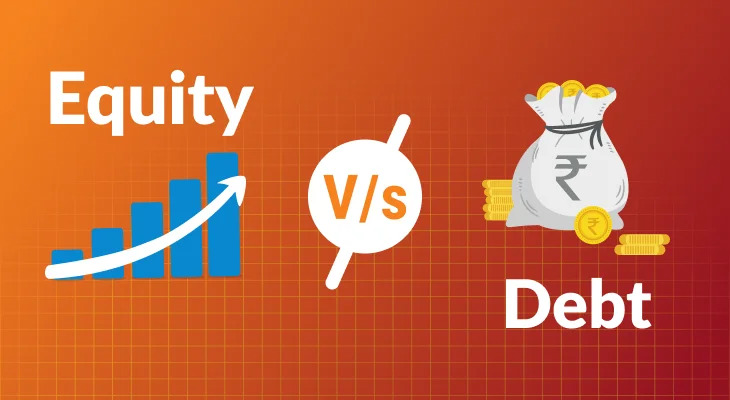Equity vs Debt Mutual Funds: Making the Right Choice

When it comes to investing in mutual funds, the two predominant options available to investors are equity mutual funds and debt funds. Each has unique features, risks, and advantages. Understanding these differences can help investors make an informed choice that aligns with their financial objectives. This article delves deep into equity mutual funds and debt funds, helping you to discern between the two and decide what aligns best with your financial goals.
Equity Mutual Funds
Definition:
Equity mutual funds primarily invest in stocks. They aim to generate high returns by capitalizing on the growth potential of companies. These funds are linked to the equity market and are impacted by market fluctuations.
Types of Equity Mutual Funds:
- Large-Cap Funds: Invest in companies with a large market capitalization.
- Mid-Cap Funds: Focus on companies with medium market capitalization.
- Small-Cap Funds: Invest in smaller or newer companies with high growth potential.
- Sector Funds: Specialize in specific industries like technology, healthcare, or energy.
- Index Funds: Aim to replicate the performance of a specific index like the Nifty 50.
Advantages of Equity Mutual Funds:
- High Returns: Over the long run, equity mutual funds have the potential to deliver higher returns compared to debt funds.
- Diversification: By investing in a variety of stocks, these funds reduce the risk of exposure to any single investment.
- Tax Benefits: Investments in equity mutual funds can offer tax exemptions under Section 80C of the Income Tax Act if invested through Equity Linked Saving Schemes (ELSS).
Risks:
- Market Volatility: The performance of equity funds can be significantly affected by market fluctuations.
- Higher Risk: Given their exposure to the equity market, these funds are considered riskier compared to debt funds.
Debt Funds
Definition:
Debt funds invest primarily in fixed-income securities like government bonds, corporate bonds, Treasury bills, and other money market instruments. They aim to offer regular income and capital preservation over a given time frame.
Types of Debt Funds:
- Liquid Funds: Invest in short-term instruments and have the least risk.
- Short-Term Debt Funds: Invest in instruments maturing in 1-3 years.
- Income Funds: Aim to provide a steady income and invest in medium to long-term bonds.
- Gilt Funds: Invest essentially in government securities.
- Credit Risk Funds: Invest in lower-rated bonds with a higher risk of default to earn higher returns.
Advantages of Debt Funds:
- Lower Risk: These funds are generally less volatile compared to equity mutual funds.
- Stable Returns: Provide more predictable returns, making them suitable for conservative investors.
- Liquidity: Allows easy withdrawal compared to fixed deposits, especially with liquid funds.
- Tax Efficiency: Long-term capital gains (holding period more than three years) are taxed at 20% with indexation, which can be more tax-efficient.
Risks:
- Credit Risk: The risk that the issuer may default on payment.
- Interest Rate Risk: The value of debt funds can be impacted by interest rate changes in the economy.
Performance Comparison
To illustrate, let’s consider an example where an investor has ₹1,00,000 to invest.
Scenario 1: Investing in an Equity Mutual Fund:
– Investment Amount: ₹1,00,000
– Average Annual Return: 10%
– Investment Period: 5 years
Using the formula for compound interest:
A = P (1 + r/n)^(nt)
Where:
– A = Amount after 5 years
– P = Principal amount (₹1,00,000)
– r = annual interest rate (10% or 0.10)
– n = number of times interest is compounded per year (1 for simplicity)
– t = time the money is invested (5 years)
A = 1,00,000 * (1 + 0.10/1)^(1*5) = 1,61,051
Scenario 2: Investing in a Debt Fund:
– Investment Amount: ₹1,00,000
– Average Annual Return: 6%
– Investment Period: 5 years
Using the same formula:
A = 1,00,000 * (1 + 0.06/1)^(1*5) = 1,33,823
From the above calculations, the equity mutual fund investment grows to ₹1,61,051, while the debt fund grows to ₹1,33,823 over five years. While equity mutual funds have a higher potential return, they also come with higher risk.
Conclusion
Choosing between equity mutual funds and debt funds depends on an individual’s risk tolerance, investment horizon, and financial objectives. Equity mutual funds offer higher returns at higher risk suitable for long-term goals like retirement planning. In contrast, debt funds provide stable returns with lower risk, making them suitable for short-term goals or regular income needs.
Choosing the right type of mutual fund is crucial to achieving financial goals. Investors should consider their financial situation, market conditions, and consult financial advisors if needed.
Disclaimer: Investments in mutual funds are subject to market risks. Investors should thoroughly assess the pros and cons of trading in the Indian financial market and consult financial advisors before making any investment decisions.
Summary
This article compares equity mutual funds and debt funds, considering their unique features, risks, advantages, and potential returns. Equity mutual funds invest in stocks and aim for high returns, but they come with higher market risks. Different types cater to various market segments, such as large-cap, mid-cap, and sector-specific funds, offering diversification and tax benefits. Conversely, debt funds invest in fixed-income securities aiming for stable returns with lower volatility and risk. They are suitable for conservative investors needing steady income or short-term investment needs. A performance comparison reveals that while equity mutual funds have the potential for higher returns over a given period, they are riskier. In contrast, debt funds prioritize capital preservation with lower but predictable returns. The article emphasizes the importance of aligning mutual fund choices with individual risk tolerance, investment horizon, and financial goals, and advises consulting with financial advisors prior to making investment decisions.









